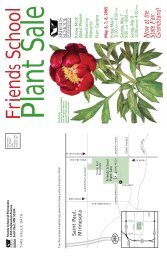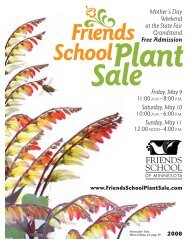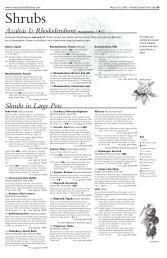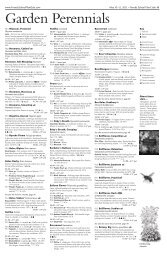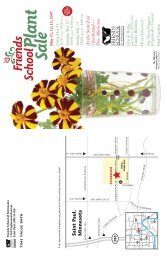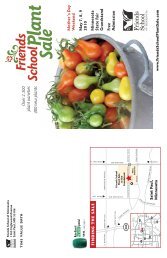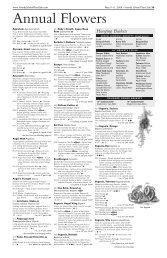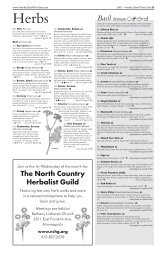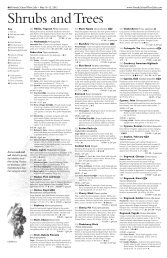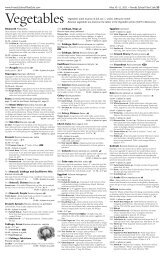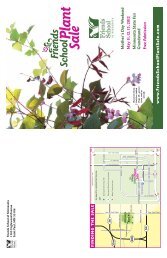View the 2013 56-page PDF here - Friends School Plant Sale
View the 2013 56-page PDF here - Friends School Plant Sale
View the 2013 56-page PDF here - Friends School Plant Sale
Create successful ePaper yourself
Turn your PDF publications into a flip-book with our unique Google optimized e-Paper software.
www.<strong>Friends</strong><strong>School</strong><strong>Plant</strong><strong>Sale</strong>.com May 10–12, <strong>2013</strong> • <strong>Friends</strong> <strong>School</strong> <strong>Plant</strong> <strong>Sale</strong> 47<br />
Shrubs and Trees<br />
Rhododendron, PJM Rhododendron hybrids<br />
Among <strong>the</strong> best varieties for our area. Dark green<br />
leaves turn purple in winter. Blooms late spring or early<br />
summer. Í∏ Ω∫¥<br />
$9.00—5.25” pot:<br />
S127 Amy Cotta ◊—A bright ball of lavender-pink<br />
flowers. This slow-growing dwarf has small, fragrant,<br />
azalea-like foliage that is bright green all<br />
summer and turns mahogany in <strong>the</strong> fall. 2–3’h by<br />
2–3’w<br />
$15.00—1 gal. pot:<br />
S128 PJM—The classic evergreen shrub with masses of<br />
mauve flowers. 4–5’h by 3–5’w<br />
Rose of Sharon Hibiscus syriacus<br />
Deer resistant upright shrubs covered in showy<br />
blooms July through September. Í∫˙<br />
$9.00—5.25” pot:<br />
S129 Azurri Satin ◊—Large, ruffled rich blue single<br />
flowers make this <strong>the</strong> star of <strong>the</strong> border or a large<br />
container. Blooms midsummer to fall. This new<br />
variety is seedless and a strong grower. 8–12’h by<br />
3–5’w<br />
S130 Chiffon Blue—Exquisite crepe-paper blue flowers<br />
have a lacy center of lighter lavender-blue<br />
petals that give it a semi-double appearance.<br />
Wine red splashes peek out from <strong>the</strong> center.<br />
8–12’h<br />
S131 Saint John’s Wort<br />
Hypericum kalmianum<br />
Sunny Boulevard—Rich yellow blooms mid July to<br />
fall followed by a fruit set that persists through winter.<br />
Prefers a cool location, well-drained soil, and some<br />
protection from winter wind. Tough once established.<br />
Will cascade nicely in a container. 3’h by 3’w Í∏ Ω¥<br />
$8.00—5.25” pot<br />
S132 Seven Son Tree<br />
Heptacodium miconioides<br />
Jasmine-scented flowers appear in whorls in<br />
September when few o<strong>the</strong>r shrubs bloom, with each<br />
whorl containing seven tiny flowers. Next, each calyx<br />
turns cherry red, seeming to give ano<strong>the</strong>r wave of<br />
bloom until November. A bonus is <strong>the</strong> reddish-brown<br />
outer bark peeling away in thin narrow strips to reveal<br />
attractive pale brown inner bark underneath. Native to<br />
China, but quite rare and may no longer exist in <strong>the</strong><br />
wild. Best in a protected spot. 15’h Í∏<br />
$7.00—4” pot<br />
S133A Smokebush Cotinus coggygria<br />
Grace—New leaves emerge an intense wine-red and<br />
mature to dusky reddish-blue. Bright orange-red fall<br />
color. Deep pink panicles in early summer. The flowers<br />
form a 6–8” puff of “smoke,” which remains effective<br />
from June through September. Can be trained into a<br />
small tree or cut to <strong>the</strong> ground in early spring. 10–15’h<br />
Í∏<br />
$8.00—4” pot<br />
S133B Smoketree Cotinus obovatus ◊<br />
Cotton Candy—Fluffy pink blooms in summer and<br />
bright orange-red fall foliage. This multi-branched<br />
shrub can be pruned to a tree form. 20–25’h Í∏<br />
$19.00—1 gal. pot<br />
S134 Snowball, Fragrant Viburnum x carlesii<br />
Valued for <strong>the</strong>ir fragrance, <strong>the</strong> flowers are pink to reddish<br />
in bud and <strong>the</strong>n open into white snowballs in late<br />
April to early May. Blue-black berries in late summer.<br />
Green serrated leaves that turn dark red in fall.<br />
Rounded, dense shrub with stiff, upright spreading<br />
branches. 4–6’h Í∏ ∫ $22.00—2 gal. pot<br />
Snowberry Symphoricarpos<br />
Grows on clay and limestone soils. Excellent for<br />
wildlife. Good for erosion control. Í∏ÓΩ∫<br />
$4.00—3.5” pot:<br />
S135 Red Snowberry, S. orbiculatus—Native with purple-red<br />
berries that persist through <strong>the</strong> winter.<br />
Good for bank plantings. Flowers are yellowwhite,<br />
flushed with rose in June-July. Tolerant of<br />
moist soils also. Prune in early spring, if needed.<br />
3–5’h by 4–8’w ˜<br />
$8.00—5.25” pot:<br />
S136 Amethyst, S. x doorenbosii—Midsummer pink<br />
blooms, followed by vibrant hot pink fruit. Dark<br />
green foliage. Attractive to birds. 3–5’h by 3–4’w<br />
S137 Spirea, Blue Caryopteris<br />
Longwood Blue—Beautiful blooms in late summer to<br />
fall when o<strong>the</strong>r flowering shrubs have quit. Mulch well<br />
for winter protection and prune back in early spring to<br />
about a foot tall. Needs good drainage. Fragrant, violetblue<br />
flowers resembling clouds of blue mist. Aromatic<br />
lance-shaped, silvery-gray leaves. 2–4’h by 2–4’w<br />
Í∏<br />
$15.00—1.5 gal. pot<br />
Spirea, Japanese Spiraea japonica<br />
Tiny-leaved foliage for ground cover or containers.<br />
Í∏ Ω∫˝<br />
$3.00—3.5” pot:<br />
S138 Alpine Gold ß—Very compact with gold leaves<br />
and pink flowers. A chance seedling from a nursery<br />
in Paynesville, Minn. 1’h<br />
S139 Magic Carpet—Red leaf tips and pink-purple<br />
flowers in summer. 1–1.5’h<br />
S140 Spruce, Bird’s Nest Picea abies<br />
Nidiformis—Flat-topped with a hollow center, this<br />
spruce looks just like its name. Slow growing and<br />
extremely hardy, this is a good choice for adding<br />
“bones” to your garden. The lush, bright green branches<br />
will keep <strong>the</strong> garden looking alive all winter.<br />
2–4’h by 4–6’w Í∏ ‰ $15.00—3 gal. pot<br />
S141 Spruce, Weeping White Picea glauca<br />
Pendula—Extremely upright and narrow, with graygreen<br />
needles on branches that weep gracefully in<br />
skirts around <strong>the</strong> base. 3’ wide at <strong>the</strong> base.<br />
12’h by 3’w Í $23.00—2 gal. pot<br />
S142 Sumac, Fragrant Rhus aromatica ß<br />
Gro-Low—A low spreader with glossy dark green<br />
foliage and superb orange-red fall color. Profuse tiny<br />
yellow flowers. Good for slopes. A low-maintenance<br />
ground cover that works well in all types of soil.<br />
1–2’h Í∏ ˝˜<br />
$4.00—3.5” pot<br />
S143 Sumac, Tiger Eyes Rhus typhina<br />
Bailtiger—Goldenleaf form of cutleaf staghorn sumac.<br />
New growth is bright chartreuse, quickly changing to<br />
yellow, both colors contrasting nicely with its rosypink<br />
leaf stems. Deeply cut leaflets drape downward.<br />
Fall color is yellow, orange and intense scarlet.<br />
6–8’h Í∏<br />
$15.00—1 gal. pot<br />
S144 Sweetgum Liquidambar styraciflua ◊<br />
Star-shaped 4–8” leaves resemble sharply pointed<br />
maple leaves and smell like camphor when crushed.<br />
Showy orange, red, burgundy, and purplish fall foliage.<br />
Spiny 1–1.5” spherical clusters appear late summer to<br />
fall and last into winter. The tree’s sap has been used<br />
for chewing gum, incense, and perfumes. Grows quickly,<br />
changing from pyramidal to rounded. Ridged bark.<br />
Prefers neutral or acid soils. A challenge to bring<br />
through our worst winters, ra<strong>the</strong>r like a Japanese<br />
maple, so protect <strong>the</strong> young tree well. It’s a very<br />
rewarding tree. 60’h by 40’w ÍÂ $7.00—1 quart pot<br />
S145 Sweetshrub Calycanthus floridus<br />
Glossy, dark green leaves with golden-yellow fall<br />
foliage. Spider-like russet-red flowers with a spicy fragrance.<br />
4–6’h by 6–8’w Í∏ ¥ $7.00—1 gal. pot<br />
S146 Tamarack Larix laricina<br />
Evergreen in appearance, but drops its needles in winter.<br />
Wildlife use <strong>the</strong> tree for food and nesting. Native<br />
to most of nor<strong>the</strong>rn North America, including<br />
Minnesota. Tamarack is especially nice in October,<br />
when its needles turn yellow. Grows rapidly. Very<br />
intolerant of shade but does well in both wetland and<br />
upland situations. 45’h ͘<br />
$18.00—2 gal. pot<br />
S147 Viburnum, Double File<br />
Viburnum plicatum var. tomentosum<br />
Multi-stemmed shrub with layers of horizontal branching<br />
and showy 4” white flowers in mid-spring. Orange,<br />
red, and purple fall color. Birds love its red fruit that<br />
matures to black in August. Attracts bees, butterflies<br />
and birds. 8–10’h by 8’w Í∏ ∫Ω<br />
$13.00—1.5 gal pot<br />
S148A Willow, Dwarf Japanese<br />
Salix yezoalpina<br />
Wintergreen—Gorgeous yellow and white catkins<br />
cover this ground-hugging pussy willow in late spring.<br />
Interesting furry foliage and good fall color. Great to<br />
use flowing through a rock garden. Good for bonsai.<br />
0.5–1’h by 6’w Í∏ ˝ ‰ $22.00—2 gal. pot<br />
S148B Willow, Golden Curls ß<br />
Salix x matsudana<br />
Corkscrew willow whose twisty branches are orangeyellow<br />
when young, and prized for floral arrangements.<br />
Wavy leaves turn yellow in fall. Tree can be cut back<br />
hard to keep it more shrubby. Very hardy at <strong>the</strong><br />
Minnesota Landscape Arboretum. 20’h by 6–10’w<br />
Í∏ ˜<br />
$6.00—1 quart pot<br />
S149 Willow, Scarlet Curls<br />
Salix x matsudana<br />
Curly leaves and twisted golden branches with scarlet<br />
stems. Color intensifies after <strong>the</strong> first frost, so if you’re<br />
looking for winter interest, this is <strong>the</strong> one. Popular at<br />
<strong>the</strong> Lake Harriet Peace Garden. 25–30’h Í ¥<br />
$18.00—2 gal. pot<br />
Winterberry Ilex verticillata<br />
Dwarf, upright, rounded, slow-growing shrub with<br />
glossy dark green foliage, good in masses, shrub borders,<br />
foundation planting, and hedges. Excellent for<br />
wet soils. These are cultivars of a Minnesota native.<br />
Note: Both pollinizing and fruiting plants are needed<br />
to get <strong>the</strong> characteristic red berries; you need only one<br />
‘Jim’ for any number of fruiting plants. ∏Ó¥<br />
$6.00—4” pot:<br />
S150 Jim Dandy—Pollinizer. 3–6’h<br />
$7.00—4” pot:<br />
S151 Red Sprite—This fruiting winterberry has excellent<br />
year-round interest, highlighted by <strong>the</strong><br />
showy display of large red berries in winter. 2–3’h<br />
S152 Wintercreeper, Variegated<br />
Euonymus<br />
Canadale Gold—Colorful evergreen, providing bright<br />
green foliage with a gold edge, turning pink-red in cold<br />
wea<strong>the</strong>r. Its dense mounding habit makes it an excellent<br />
border plant. 4’h by 3.5’w Í∏Ó<br />
$3.00—3.5” pot<br />
S153 Yew Taxus media<br />
Sunburst—A cool lime-green evergreen with a fresh,<br />
healthy color. Fine textured foliage emerges gold in<br />
spring, changes to yellow-green in summer. A great<br />
landscape plant that is adaptable and easy to grow.<br />
7’h by 10’w Í∏ ¥ $25.00—2 gal. pot<br />
Tamarack<br />
Snowberry<br />
Watch for<br />
<strong>the</strong> birdie!<br />
ı<br />
<strong>Plant</strong>s marked<br />
with <strong>the</strong> bird icon<br />
are best for<br />
providing food to<br />
birds in spring<br />
when o<strong>the</strong>r foods<br />
are in low supply.<br />
ROUNDing UP?<br />
The <strong>Friends</strong> <strong>School</strong> <strong>Plant</strong> <strong>Sale</strong> is both a community<br />
event and a fund-raiser for <strong>the</strong> <strong>Friends</strong> <strong>School</strong> of<br />
Minnesota.<br />
In addition to beautifying your block or planting<br />
healthy vegetables for your family, we hope you will<br />
consider “rounding up” your bill to <strong>the</strong> nearest $5.<br />
Or consider a donation of an additional $5, $10, or<br />
$20 to <strong>the</strong> <strong>Friends</strong> <strong>School</strong>’s scholarship fund.<br />
Thank you for considering a<br />
round-up donation!<br />
Selecting for Bonsai<br />
These plants, selected from <strong>the</strong> catalog, are most likely to make<br />
good bonsai.<br />
The list is based on <strong>the</strong> species only, since individual specimens<br />
may not make good bonsai depending in <strong>the</strong>ir size and o<strong>the</strong>r<br />
characteristics.<br />
Rare <strong>Plant</strong>s<br />
Alpine Azalea (U002)<br />
Elm, Miniature (U009–U010)<br />
Pine, Japanese Umbrella<br />
(U052)<br />
Eucalyptus, Rainbow (U073)<br />
Pomegranate (U080)<br />
Fruit<br />
Apple (F001–F005)<br />
Cherry, Bush (F018–F020)<br />
Fig, Hardy (F030)<br />
Annuals<br />
Eucalyptus (A228)<br />
Shrubs and Trees<br />
Azalea, Lights (S012–S014)<br />
Boxwood (S023–S024)<br />
Cypress, Bald (S036)<br />
Cypress, False (S037–S038)<br />
Ginkgo (S055)<br />
Juniper, Spreading<br />
(S079–S080)<br />
Larch, Japanese (S083)<br />
Maple, Japanese (S113)<br />
Pine, Mugo (S119–S120)<br />
Tamarack (S146)<br />
Yew (S153)





